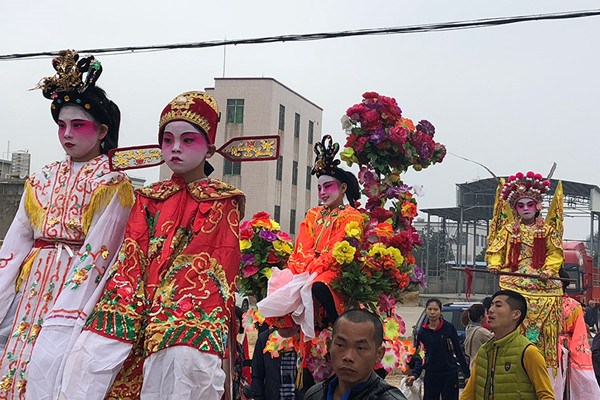
Piao Se is a traditional festival performance during Nian Li, which presents children dressed up as characters from ancient Chinese mythological and historical stories. (Photo by Pan Mengqi / China Daily)
For many people on the coast of Guangdong province, the Lunar New Year is more than a chance for a grand feast, it is a reminder for the young of their 1,000-year cultural tradition called Nian Li.
The annual folk performance in Zhanjiang city that takes place during the Spring Festival is an intangible cultural heritage in Guangdong province.
It includes a folk parade, worship of ancestors and a grand banquet where everybody in the village is invited to the stage, including strangers.
Liu Lan, a folk culture researcher in Guangdong Ocean University, said the tradition can be traced back to the Tang Dynasty (618-907).
Tai Ping Huan Yu Ji, a 10th-century geographical treatise by Yue Shi, says locals in the western part of what is now Guangdong celebrated the traditional harvest festival instead of the new year as early as the Tang Dynasty by dressing up boys and girls, dancing, singing and writing poems to celebrate a good harvest and pray for good weather for the crops.
This year, the celebration took place on Feb 18 on Donghai Island.
People got up at 3 am to prepare. Adults placed sacrificial offerings including chicken, pork, rice, incense, liquor and some snacks in their ancestral temples to worship the ancestors, while the young dressed up for the "parade of gods".
Jin Youfu, who works in the provincial capital Guangzhou, returns to his hometown of Shuiluo village every year for the Spring Festival reunion with his family, and to fulfill his "mission" in the event.
"I am one of the flagman in the 'parade of gods'", the 25-year-old said, adding that he has been chosen as the flagman four times since he was 17.
This year, Jin and 78 others carried the flags for four hours during the parade that wound its way through eight neighboring villages.
Lin Jinqiao, the village head in Danliao, said the tradition of choosing young people for the parade is not only because "they are strong enough to endure the work".
"In 'parade of gods' some villagers need go to the temple and hold a rite to invite the gods, some need to shoulder the gods' sculptures, some will do the lion dance and some need to carry the flags," Lin said. "These are all history and we don't want our next generation to forget, thus we choose the young to take part."
The youngest participant in the parade this year, who is five years old, dressed up as legendary Song Dynasty (960-1279) heroine Mu Guiying in an art form presenting legendary and fairy tale figures by using a hidden stick for support.
Following the parade was the highlight of the event-the grand feast. All friends and relatives, even strangers, were invited to improve and maintain ties.
The village head Lin said, "our village has 4,500 residents, but over 3,000 of them choose to work in other parts of China and even abroad."
"Nian Li is the tradition that brings us together and reminds every generation our roots," he said.


















































